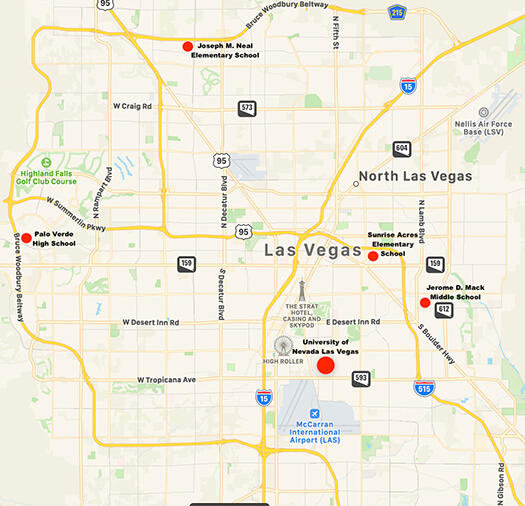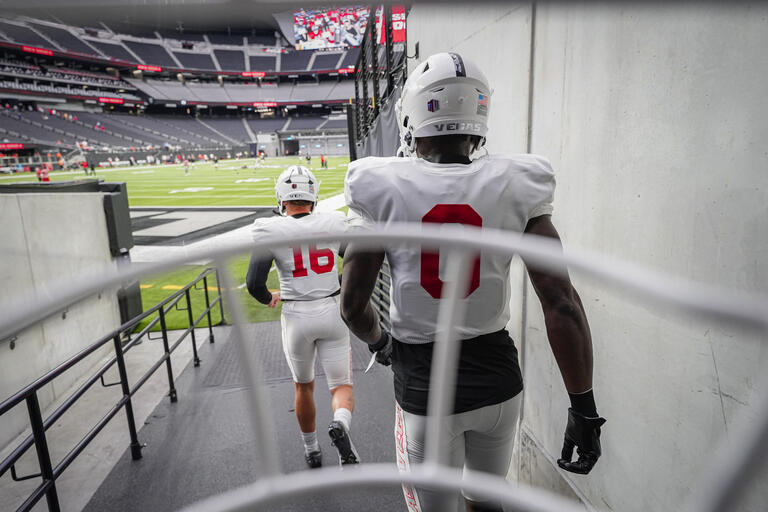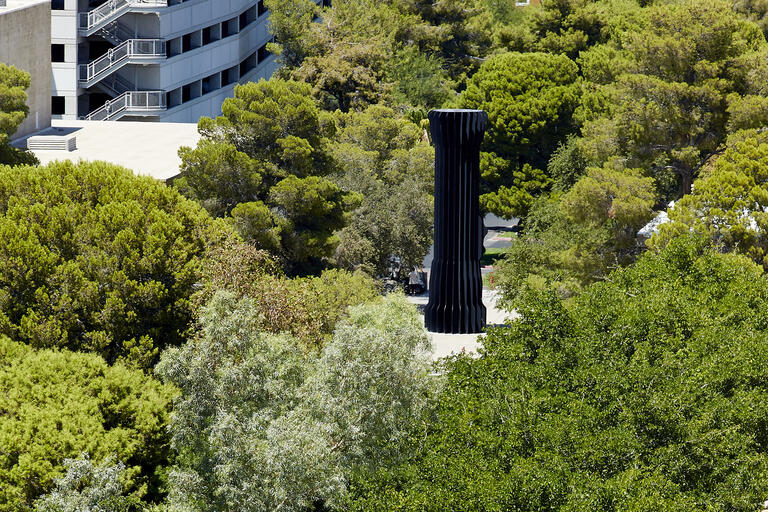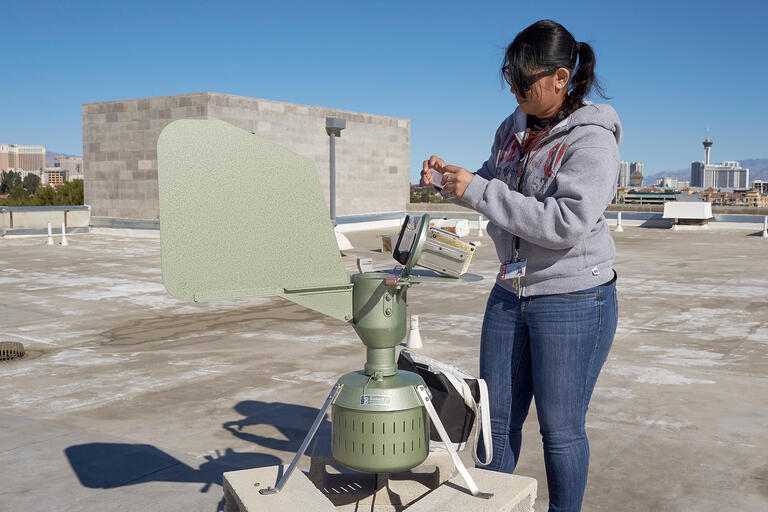CCSD/UNLV Pollen Monitoring Program
What These Levels Mean
- Absent
No symptoms. - Low
Only individuals extremely sensitive to these pollens will experience symptoms. - Moderate
Many individuals sensitive to these pollens will experience symptoms. - High
Most individuals with any sensitivity to these pollens will experience symptoms. - Very High
Almost all individuals with any sensitivity at all to these pollens will experience symptoms. Extremely sensitive people could have severe problems.
Pollen and Mold Counts
We provide updated pollen and mold counts for the Las Vegas area. Below is a map of the current collection stations.
UNLV Site
Our UNLV station is certified by the National Allergy Bureau (NAB). Visit the NAB Pollen and Mold Report page for more information about daily pollen and mold counts in the UNLV site.
CCSD Sites
Currently we have 4 Clark County School District sites. These school samples are collected weekly, 365 days a year.
- Jerome D. Mack Middle School
- Sunrise Acres Elementary School
- Joseph M. Neal Elementary School
- Palo Verde High School
Remote Sites
- Jean, NV
Seasonal Allergy Management and Treatment
- Monitor pollen and mold counts. Weather reports in newspapers and on radio and television often include this information during allergy seasons.
- Keep windows and doors shut at home and in your car during allergy season.
- To avoid pollen, know which pollens you are sensitive to and then check pollen counts. In spring and summer, during tree and grass pollen season, levels are highest in the evening. In late summer and early fall, during ragweed pollen season, levels are highest in the morning.
- Take a shower, wash your hair and change your clothes after you’ve been working or playing outdoors.
- Wear a NIOSH-rated 95 filter mask when mowing the lawn or doing other chores outdoors, and take appropriate medication beforehand.
- If symptoms persist then consult an allergist.
Education
2025
Ferron Elementary School
- Pollen and Allergies
2023
Ferron Elementary School
- UNLV Pollen Program
2022
Addeliar Guy Elementary School
- UNLV Pollen Program
2021
Cashman Middle School
- Mold, Pollen Introduction, and Urban Green Spaces at the AMSE
2020
Findlay Middle School
2019
Lied Stem Academy
2018
Pollen and Mold Lectures at the John C Fremont Middle School
Pollen and Mold Lectures at the Carroll M Johnston Middle School
2015
Pollen and Mold Lectures at the Desert Rose Adult High School
Pollen and Mold Lectures at the UNLV Rebel STEM Academy
2014
Pollen and Mold Lectures at the West Career & Technology Academy
Research
Publications
- 2018 : Variation in airborne pollen concentrations among five monitoring locations in a desert urban environment (Environmental Monitoring and Assessment)
- 2017: Comparison of Airborne Mold in the Mojave Desert and Las Vegas (Journal of Allergy and Clinical Immunology)
Presentations
- American Academy of Allergy Asthma & Immunology (AAAAI) Annual Meeting
- 2025 - Annual Comparison Of Ragweed Pollen Concentrations in Las Vegas and Jean From 2019-2023
- 2024 - Comparison of the Airborne Fungal Spore Concentration in Las Vegas and the Mojave Desert From 2020-2022
- 2023 - Annual Comparison of Grass, Tree, and Weed Pollen in Las Vegas, Nevada, From 2019-2021
- 2022 - Comparison of the Airborne Fungal Spore Concentrations in the Mojave Desert and Las Vegas From 2016-2020
- 2021- Annual Comparison of Weed Pollen in Las Vegas and the Mojave Desert From 2017-2019 (Presented virtually)
- 2020 - Annual Comparison of Grass, Tree, and Weed Pollen in Las Vegas From 2015-2018 (Presented virtually)
- 2019 - Annual Variation Among Tree Pollen In Las Vegas From 2015-2018
- 2018 - Comparison of Airborne Mulberry and Olive Pollen Concentrations in Southern Nevada in 2016
- 2017 - Comparison of Airborne Mold in the Mojave Desert and Las Vegas
- 2016 - Seasonal Tree, Weed and Grass Pollen Patterns in the Las Vegas Valley
- 2015 - Mulberry - A Chronic Pollen Offender in Las Vegas
- Nevada Public Health Association (NPHA) Annual Meeting Las Vegas
- 2025 - Airborne Pollen and Mold Monitoring Program to Assess Allergen Trends in Las Vegas and Jean, NV
- 2022 - Comparison of Mulberry and Olive Pollen in 2020 Among Five Monitoring Locations in Las Vegas
- 2020 - Annual Comparison of Grass, Tree, and Weed Pollen in Las Vegas from 2015-2019 (presented virtually)
- 2018- Variation of Airborne Mulberry and Olive Pollen Concentrations Among Five Locations in Las Vegas in 2016
- American College of Allergy, Asthma, and Immunology (ACAAI)
- 2016 - Comparison of Airborne Pollen in the Mojave Desert and Las Vegas
- 2015 - Mulberry and Olive Pollen in Las Vegas
- American Society for Microbiology (ASM)
-
2024 - Comparison of Airborne Fungal Spore Concentrations in Las Vegas from 2020 - 2022
-
News
In the News
Contact
Asma Tahir, MPH
Pollen Program Supervisor
School of Public Health
University of Nevada, Las Vegas
Phone: 702-895-1285
Email: UNLVPollen@gmail.com
Mark Buttner, Professor
Principal Investigator
School of Public Health
University of Nevada, Las Vegas
Email: mark.buttner@unlv.edu
Dennis A. Bazylinski, Professor
Co-Principal Investigator
School of Life Sciences
University of Nevada, Las Vegas
Email: dennis.bazylinski@unlv.edu



